Ingenious Toy Storage Ideas to Revolutionize Your Space
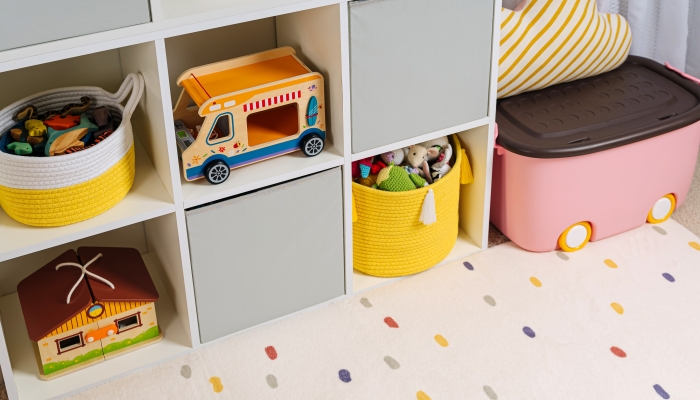
This post may contain affiliate links; please see our terms of use for details.
- Consider getting rid of some toys as you organize.
- Songs and games help kids get involved in cleaning up.
- There is no shortage of tips to make toy clean-ups a success.
- These 13 ways to store toys are sure to meet the needs of any family.
With or without a dedicated playroom, toys can easily begin to run the house. I’ve stepped on my fair share of toy cars and Lego pieces to attest to it myself! That said, finding a place to fit all the toys is no easy task, but it’s not impossible either. A solid toy organization system can be your secret weapon to a clean, clutter-free home.
Whether you’re trying to organize toys into small spaces, make use of hidden storage, or just discover some brilliant toy storage ideas you may never have thought of, we’ve got you covered! Stay put to explore the best toy storage ideas, along with tips on how to involve kids in cleaning up and organizing their toys.
Toy Storage Ideas: Keeping Your Home Safe and Clutter-Free
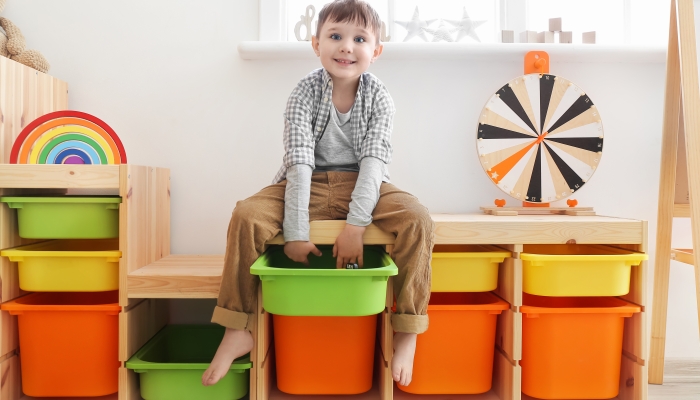
It can happen so quickly. One minute you’ve got a handle on your kid’s toys; the next, a holiday or birthday has come and gone, and now your home is overflowing. At first, it may not seem like that big of a deal. More to play with, right? As it turns out, decluttering your toys is best. For starters, more toys usually equal less interest.
In his article, The Changing World of Toys and Toy Play11. Elkind, D.. The Changing World of Toys and Toy Play. Exchange. 2005. https://www.researchgate.net/profile/David-Elkind/publication/265665311_The_Changing_World_of_Toys_and_Toy_Play/links/579c959b08ae6a2882f2e1a1/The-Changing-World-of-Toys-and-Toy-Play.pdf , Professor of Child Development David Elkind says, “Too many toys, given too often, contribute, among other things, to the decline in the imaginative activities of young children.” They become so inundated with new things that they’re not given the opportunity to use their imagination using old toys.
Tons of toys also lead to less care for them. After all, why take care of all their toys when they have so many or new ones are constantly coming in? Attention spans also seem to be affected when your home is cluttered with toys. The clutter can overwhelm your kids and prevent them from sitting with and playing with a toy for longer.
How can you prevent toy clutter while also keeping your child safe from these potential pitfalls? As you may have guessed, getting rid of some toys is a good start. Chances are, they may have too many, and that affects not only their playtime but also the clutter.
Next, pick and stick to a storage style for your child’s toys. Organizing them will cut the clutter and show your child exactly where and how the toys are stored when they’re not being used. This helps set the expectation, leaving less clutter around the house as the day progresses.
13 Practical and Smart Toy Storage Ideas

While the classic clear plastic bins are always an option, they’re certainly not the only way to go about organizing kids’ toys. Consider these 13 practical and smart toy storage solutions to keep things clutter-free.
- Toy Hammock: A fun and cost-effective way to keep toys cleaned up, toy hammocks are perfect for stuffed animals in particular.
- Toy Organizer: From bins to drawer styles, toy organizers are a simple toy storage idea that provides easy access and keeps things visible for your kids.
- Toy Bench: Doubling as a seating area, toy benches are a fun place for kids to sit, and they also hide the toys out of plain sight.
- Baskets: Simple yet effective, baskets hold different sizes of toys, and some are even machine washable to make regular cleaning a cinch.
- Floor Cubbies: Also known as cubes, floor cubbies can be used as shelf storage or basket storage if you buy the cube-like baskets that accompany them.
- Hanging Cubbies: For an off-the-floor option, hanging cubbies work inside a closet and are easily concealed when toys aren’t in use.
- Shelves: Whether wall-mounted or free-standing units, shelves can store and display toys, sometimes offering drawer combinations as well.
- Carts: Wire, plastic, or wood, rolling carts are an awesome organizing choice for both indoor and outdoor toys, easy to move for both parents and kids.
- Day Bed: A personal favorite, day beds or cribs with storage keep your little one’s room clutter-free while keeping toys easy to access.
- Clear Labeled Bins: Using clear labeled bins not only helps your little one to see what’s inside, but the labels can help with word recognition and identification.
- Shoe Organizer: A less common but incredibly handy choice for organizing is shoe organizers, ideal for toys that are plentiful in pieces or just small toys.
- Peg Boards: Great for art supplies or lego type toys, peg boards can hold different containers to organize pieces or even attach hooks for large items.
- Other Furniture: From storage cabinets to dressers to armoires and everything in between, don’t neglect normal furniture pieces as storage space for toys.
Should Kids Get Involved in Cleaning and Storing Toys?
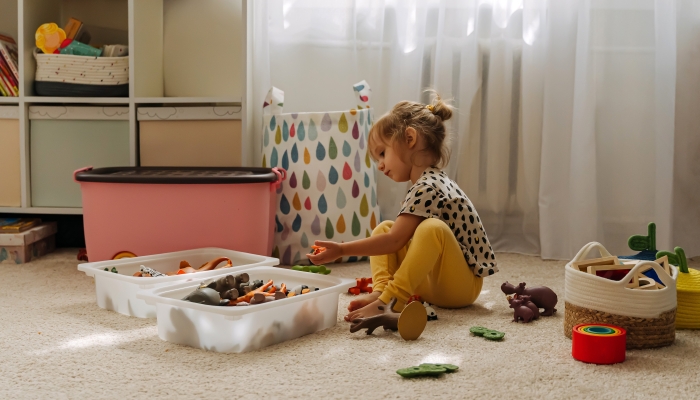
Cleaning up toys may be a small task, but it’s one that teaches kids some big lessons. That’s why kids should get involved in cleaning up and storing their toys. By doing so, they develop a sense of responsibility and independence. They’ll also recognize the importance of teamwork as they work with a group towards a common goal.
It’ll also teach them to value the toys they do have and how they should treat the things they’re given. Once they’ve mastered picking up their toys, you can even teach them how to clean toys with soap and water when you have to tackle that chore! All these skills build on one another and will prove helpful as they grow older.
How to Encourage Your Kid to Clean Up and Organize Their Toys
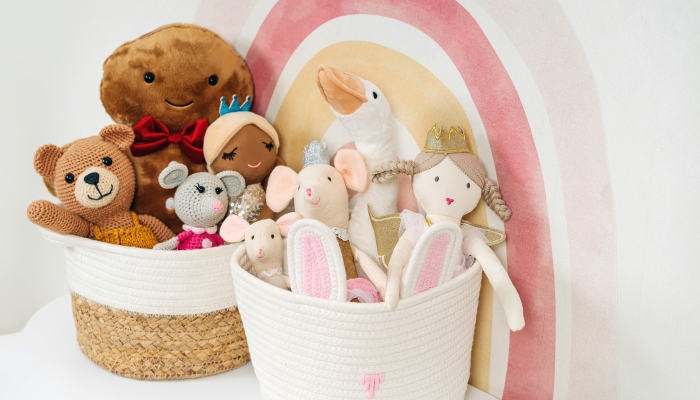
Of course, for some kids, getting them to participate is a struggle in itself. The best place to start is by showing them. Cleaning up alongside your kids makes it less confusing when they know where things should go and the expectation and routine of clean-up time.
You can also make it a fun task! Maybe there’s a clean-up song that really motivates them, or maybe they’re more apt to clean when you make it into a game. For instance, racing to see who can pick up the most toys first or seeing how many toys can fit in one of the toy baskets. Another fun game may be to collect all the red toys first or to count how many trucks are out of the basket. These games can also introduce color and early preschool math concepts.
Remember that cooperation in cleaning always goes better when your child is already transitioning from one thing to the next. If they’ve just started playing with something that interests them, it’ll be harder to start a cleanup.
If you find yourself in a power struggle and your little one is refusing to clean up, there are a few strategies you can try. For kids learning to clean up, offer to help them. When they see you modeling the desired actions, it’s much easier for them to participate. For older children, visual aids like charts, checklists, or schedules may help, with clean-up times clearly listed.
For a more hard-hitting approach, you can create age-appropriate consequences for leaving their toys out. For example, the toys they refuse to clean up will be taken away and stored for a designated amount of time.
Helpful Tips on Cleaning and Organizing Your Kid’s Toys
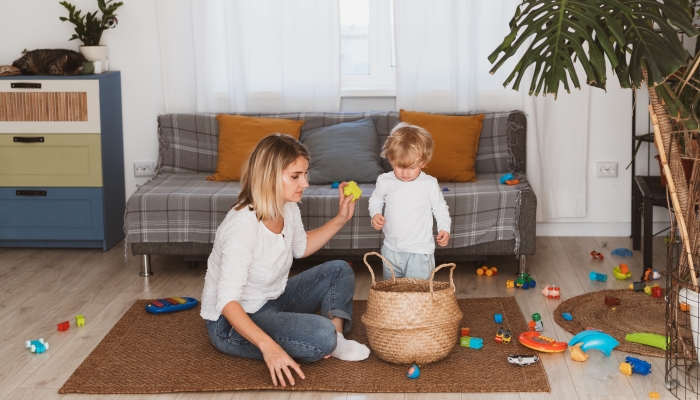
We’ve already touched on several practical ways to get your kids involved in keeping your home clutter-free from toys, but it never hurts to have more tools at your disposal! Check out some more helpful tips on cleaning and organizing your kid’s toys.
- Be Consistent: It’s tempting to let kids off the hook or forego consequences, but in the end, that doesn’t teach them anything. Stay consistent, and clean-up times will get easier as you go!
- Offer Praise: Don’t let their hard work go unnoticed. When they clean up, make sure you let them know how proud of them you are. Reinforcing their hard work will create positive associations.
- Give Options: If you’re facing resistance off the bat, try giving your child some options, putting the power back in their hands. For instance, let them decide which toys to pick up first or which room they want to start in.
- Be Specific: Some kids need a little more direction. Simply saying, “It’s time to clean up,” may not be enough. You can try telling them exactly which toys to start with or which basket to fill up first.
- Limit Toys: Clean-up times can be overwhelming if every single toy has been pulled out at once. It’s helpful to limit the toys your child can bring out at a time so there’s less to manage at clean-up time.
- Pick Times: Select a few clean-up times throughout the day. This will mean no surprises for your little one when the time comes for cleaning, and it keeps everyone from constantly cleaning throughout the day.
- Save It: Nothing is worse to a child who’s worked so hard to create something super special, just to have to tear it all down. If they want to keep their creation intact, set it aside and allow them to clean up everything else.
- Clean Throughout: If timed pick-ups aren’t your style, try having your child clean up their toys before selecting new ones. That’ll mitigate some of the big messes that create the most pushback.
References
- Elkind, D. (2005). The Changing World of Toys and Toy Play. Exchange, Nov/Dec, 11-12. https://www.researchgate.net/profile/David-Elkind/publication/265665311_The_Changing_World_of_Toys_and_Toy_Play/links/579c959b08ae6a2882f2e1a1/The-Changing-World-of-Toys-and-Toy-Play.pdf
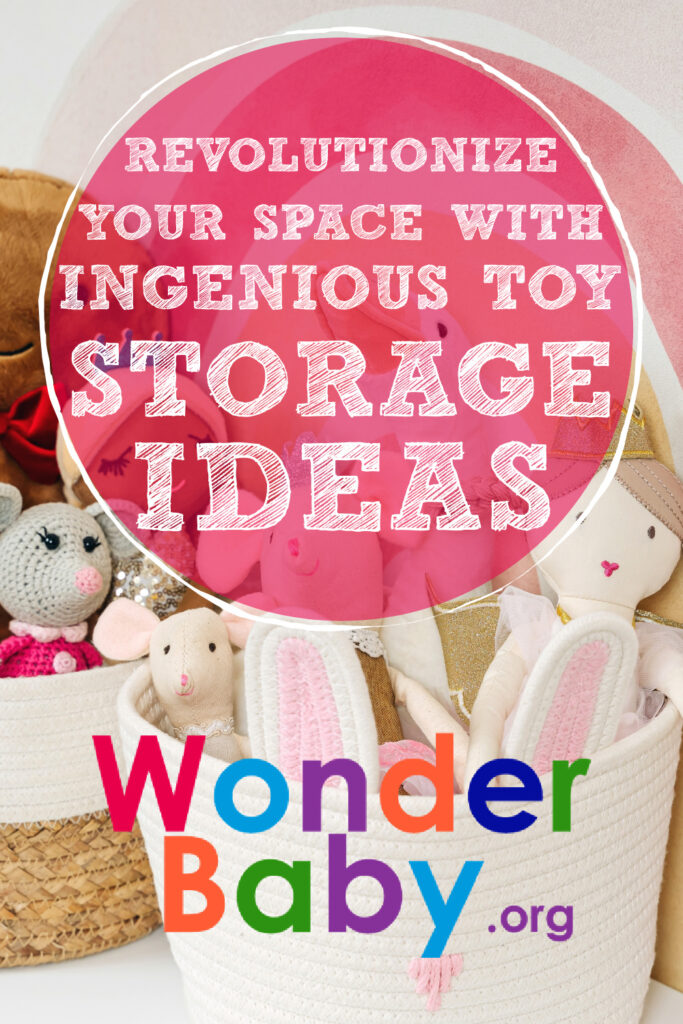
Related Posts

Braille and Literacy, Toys, Visual Impairment
24 Braille Toys for Kids Who are Blind
Everything from alphabet blocks to raised line coloring pages and activity books to puzzles to card and board games... and so much more! And it's all in braille ready for...

Holiday Crafts and Ideas
Should Parents Lie to Their Kids About Santa Claus?
Should parents lie about Santa? Find out how to balance trust, magic, and holiday traditions right here!
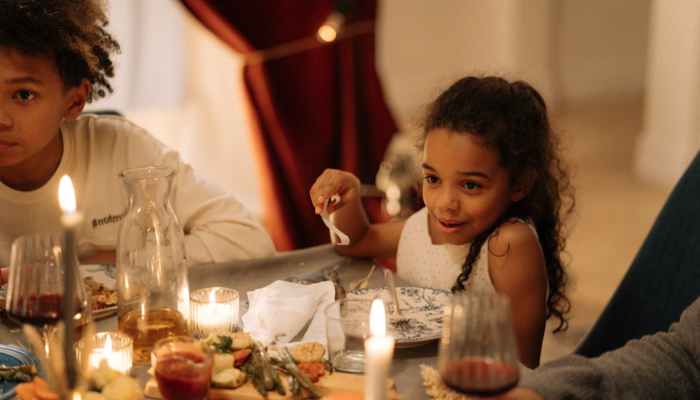
Holiday Crafts and Ideas, Special Needs
5 Tips for a Peaceful Thanksgiving with Your Child with Disabilities
Thanksgiving can be a joyful yet overwhelming holiday, especially for families with children who have sensory, motor, or dietary needs.